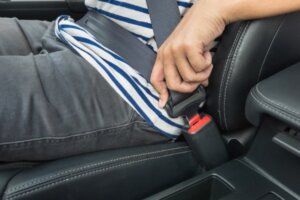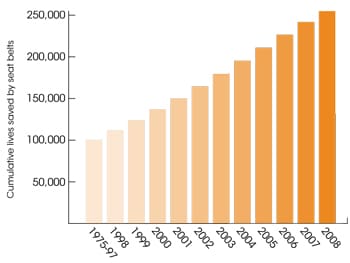SEAT BELT SAFETY – NOT WEARING SEATBELT MN AUTO INJURY ATTORNEYS
Below is an article a car accident lawyer found on the Center for Disease Control Web Site. The article lays out the importance of seat belts to reduce injury in car crashes. Our car accident attorneys see too many cases in Minnesota where the passengers were injured far worse because they were not wearing a seat belt.
When a person is injured more because they weren’t wearing a seat belt, they want to know if they can still sue or still have a case against the other driver. The answer is yes. The negligent driver who caused the car crash still must pay for ALL damages and injuries caused by the bad driving. Fortunately, the law in MN restricts evidence at trial about seat belt use. However, the insurance company and juries sometimes feel otherwise, regardless of what the law says.
If you are injured in an auto accident in MN while not wearing your seatbelt, call our office for a free consultation. A top car accident attorney will explain your rights. We have offices in Minneapolis, Edina, and Woodbury MN. An auto accident lawyer can also come to your home or hospital in Anoka MN, Forest Lake, White Bear Lake, St. Paul, Brooklyn Park, and Maple Grove. Also, Rogers MN, Chanhassen, Chaska, Bloomington MN, Albert Lea, Burnsville, and other cities throughout MN. Even if you were injured in a car accident with no seat belt, you have rights. The primary focus of our auto accident lawyers is to make sure you are fairly compensated for your injury.
Policy Impact: Seat Belts

What’s the Issue?
Motor vehicle crashes are the leading cause of death in the first three decades of American’s lives. Crashes killed over 33,000 people and injured another 2.2 million in one year. More than 70% of these were in passenger vehicles and trucks.
More than half of the people killed in car crashes were not restrained at the time of the crash. Wearing a seat belt is the most effective way to prevent death and serious injury in a crash.
Seat belt use is on the rise. Laws, education, and technology have increased seat belt use from 11% in 19812 to nearly 85% in 20103, saving hundreds of thousands of lives. Yet, about 1 in 7 people still don’t buckle up.
There are proven policies to increase seat belt use and save lives.
More than 90 people die in motor vehicle crashes every day.
What Do We Know?
- Most drivers and passengers killed in crashes are unrestrained. 53% of drivers and passengers killed in car crashes in 2009 were not wearing restraints.
- Seat belts dramatically reduce risk of death and serious injury. Among drivers and front-seat passengers, seat belts reduce the risk of death by 45%, and cut the risk of serious injury by 50%.
- Seat belts prevent drivers and passengers from being ejected during a crash. People not wearing a seat belt are 30 times more likely to be ejected from a vehicle during a crash. More than 3 out of 4 people who are ejected during a fatal crash die from their injuries.
- Seat belts save thousands of lives each year, and increasing use would save thousands more. Seat belts saved almost 13,000 lives in 2009. If all drivers and passengers had worn seat belts that year, almost 4,000 more people would be alive today.
These facts show that increasing seat belt use is critical to reduce injury and saving lives.
Most People Killed in Crashes are Drivers or Passengers
Seat Belts Have Saved an Estimated 255,000 Lives Since 1975

In one year alone, crash deaths and injuries to drivers and passengers cost $70 billion in medical and lost work costs.
What Can We Do?
Seat belts protect people from needless death and injury. But whether it is because they are in a hurry, distracted, or they simply forget, many people don’t wear their seat belts, and thousands die as a result. CDC recommends effective, well-enforced seat belt laws to ensure that every person in every seat buckles up on every trip.
Primary enforcement states have seat belt use 9 percentage points higher than secondary states.
CDC Recommendations
Primary enforcement of seat belt laws. Laws requiring seat belt use are either ‘primary’ or ‘secondary’ enforcement laws. Primary enforcement laws allow police officers to pull over drivers and issue tickets just because the drivers or their passengers aren’t wearing seat belts. Secondary enforcement laws only allow police officers to issue tickets for seat belt violations if drivers have been pulled over for some other offense.
Secondary enforcement significantly limits the ability of officers to enforce seat belt laws. Rates of seat belt use are 9 percentage points higher in primary enforcement states than secondary states.
If the overall prevalence of seat belt use in states with secondary enforcement laws had matched the higher prevalence in states with primary laws, an additional 7.3 million adults would have buckled up in 2008.8 Increasing the number of states with primary enforcement seat belt laws covering all positions will increase seat belt use and save lives.
Enhanced enforcement of existing seat belt laws. ‘Enhanced enforcement’ programs seek to better support seat belt laws by either increasing the average number of citations each officer issues or by increasing the number of officers on patrol. These measures are supported by publicity campaigns, like the successful ‘Click It or Ticket’ initiative.
Research has shown that enhanced enforcement programs increase seat belt use by a median of 16 percentage points. Communities that follow this model and implement these programs will increase seat belt use.
Enhanced enforcement increases seat belt use by a median of 16 percentage points.
Increased fines for seat belt violations. Well-enforced seat belt laws work because most people would rather buckle up than possibly pay a fine. But in many states, fines for violating seat belt laws are so small that they don’t motivate people to wear their seat belt.
Increasing a seat belt fine from $5 to $100 can increase seat belt use by more than 10 percentage points. Even a modest increase can make a difference. For instance, an increase from $25 to $60 can increase belt use by 3 to 4 percentage points.
States should consider increasing fines to a level that will encourage seat belt use.
